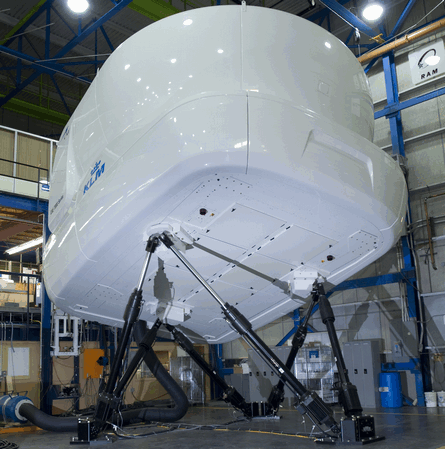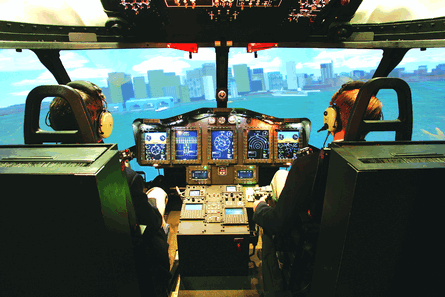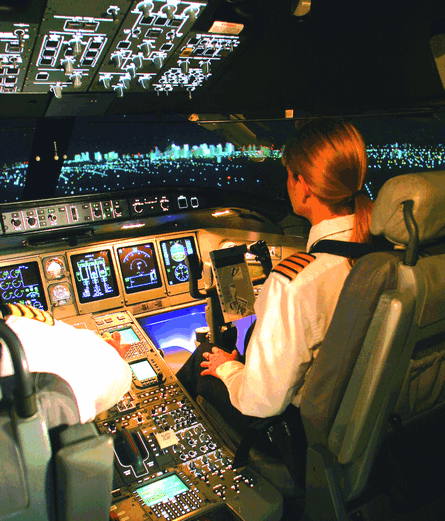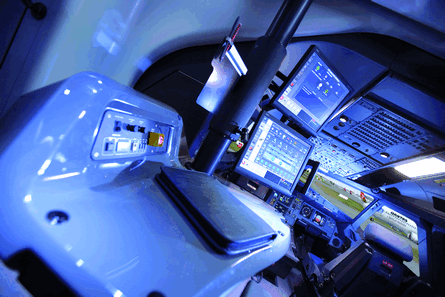The commercial flight simulation market has been shaped by the tension between the thrust of technology and the drag of regulation. Technology enables synthetic training, but regulation makes it usable and qualification standards have failed to keep pace with advances in simulation.
With aircraft deliveries and pilot demand at record levels, and driving the need for simulators, the industry has moved to update and simplify the qualification standards to encourage the use of technology to make training more efficient and flying safer.
Training has become a global industry, and efforts have been focused on harmonising the standards internationally to make it easier for operators to secure annual approvals from the many regulatory authorities that must qualify simulators for training.
 |
|---|
© CAE |
Previous harmonisation efforts led to the creation in 1992 of an International Civil Aviation Organisation manual describing the minimum requirements for qualifying aircraft flight simulators. This was updated in 2001 to reflect changes in simulation technology, but only defines the highest level of flight simulator.
The result was the harmonisation of qualification requirements for FAA and JAA Level D and ICAO Level 2 simulators. These high-fidelity devices, which permit zero flight-time training, have become the de facto standard for the industry and accounted for 70% of all US Federal Aviation Administration simulator approvals between 2000 and 2005.
But there is a distinct lack of harmonisation of standards for lower-level devices. The FAA has six levels of flight training device (FTD), plus others for PC-based desktop trainers, while Europe has more. ICAO, meanwhile, has identified the need for four additional levels of training device to support the multi-crew pilot licence (MPL), intended as a single global minimum performance standard for pilot training.
Standards Review
In November 2005, at the request of the FAA, the UK Royal Aeronautical Society (RAeS) agreed to establish an international working group to review the ICAO technical standards and expand them to include all devices from desktop trainers to full-flight simulators for both fixed-wing aircraft and helicopters.
"We felt it was the right time to harmonise and modernise the standards, to clean them up so they would be more streamlined and simpler for industry," says Stephane Clement, CAE manager, training solutions, verification and validation. "Lower-level FTDs like flat-panel trainers were becoming more popular, but it was not clear if they needed qualification, or at what level." There was also growing interest in using simulators for helicopter training. "The November 2005 meeting at the RAeS in London asked if it was time to upgrade flight simulation training standards, and the very strong answer was 'yes'," Clement says. There were many reasons, he says, including the need for more harmonisation, and to accommodate new technology, changes in the regulatory environment and the emergence of MPL.
 |
|---|
© FlightSafety |
"They were unanimous that they wanted more harmonisation," Clement says. "The FAA and JAA have different levels and names for FTDs. There is no easy correlation, which makes mutual recognition difficult." The FAA proposed that the RAeS form an international working group to harmonise all levels and align the devices with their purpose.
The RAeS, which had led the earlier efforts to create and update the ICAO qualification standards, established the working group in March 2006, drawing its members from aircraft and simulator manufacturers and operators, as well as training and research centres, and from as many regions as possible.
Where previously simulator standards were updated in response to technology improvements, the IWG decided to undertake a fundamental review to establish the simulation fidelity levels needed to support the required training tasks for each type of license, from private pilot to air transport pilot.
The working group formed two subgroups, training and technical. "The training group listed all the training tasks pilots have to do, from PPL to ATPL to recurrent to MPL," says Clement. To perform a take-off, for example, there are seven major training tasks listed, from pre-take-off preparation to managing abnormal and emergency situations.
For each task on the overall list, the training subgroup then decided what level of fidelity - generic, representative or specific to the aircraft - was required for each of 12 features of the simulator, including cockpit, flight model, systems, flight controls, visual, motion and environment, such as air traffic control and weather.
"The simulator was broken down into pieces and, for each piece, an assessment was made of the real training need for the task," says Clement. "It was a humongous job: 50,000 little decisions to make. They had to decide whether the task was training versus demonstrating proficiency and determine the fidelity level."
The result of the group's efforts is a massive matrix which, within every one of the approximately 150 training tasks for each of the 12 license and rating types, assigns fidelity levels to each of the 12 simulator features.
The technical subgroup, meanwhile, took the results of this training analysis and looked for natural groupings of fidelity levels, says Clement. They have been rolled up into seven new device types - Levels 1 to 7 - spanning the complete spectrum from desktop trainer to full-flight simulator.
The intent is for ICAO to adopt the seven levels as the new international standards for flight simulation training devices. "The IWG's purpose is to produce a draft ICAO document," says Clement. "And for the devices in the draft we really know where they come from, instead of them being devices built on technology evolutions."
ICAO Level 7, the highest fidelity device, can be used for type and class ratings, recurrent and recency training, and MPL Phase 4 advanced training. Level 7 is close to today's Level D, but adds the requirement for ATC simulation, and the required field of view of the visual display system has been increased.
"An existing Level D simulator could meet or almost meet Level 7," says Clement. "Today, Level D requires a horizontal field of view of 180°. Going forward, we have settled on 200°, which is feasible with three channels." The reason for the increase is the requirement to train for curved approaches, he says.
"Today there are no requirements, but on Level 7 there will be a requirement for ATC simulation," Clement says. "Accidents are caused by human factors such as miscommunications, and cadets going through MPL need exposure to the airport environment during training. ATC simulation allows total immersion." Air traffic control simulation can be added to Level D simulators as a software kit, he says.
Future Proofing
 |
|---|
© FlightSafety |
The proposed scheme eliminates today's Level A, B and C standards for full-flight simulators. The only devices requiring motion systems are the full-fidelity Level 7 and the Level 6, which has reduced motion and is intended for MPL Phase 3 intermediate training. "We have struggled to define the second level down. The only requirement is for MPL Phase 3, but we don't have enough knowledge about that yet," says Clement.
Level 5, a fixed-based simulator to be used for type rating and recurrent training, rounds out the shortlist of new device types required to have aircraft-specific fidelity. The others are fixed-based devices with medium fidelity, representative of the class of aircraft, or lower "generic" fidelity, not specific to an aircraft type.
Outwardly, the new device types will look similar to today's FFSs and FTDs - Levels 5 to 7 having aircraft-specific enclosed cockpits, 6 and 7 on motion and with collimated visuals - but the difference is the simulator features are linked to training tasks and not to tied to technology. This should make the new standards "future proof", Clement says. "The fidelity levels are decided by training, and are not technology based. I don't see them being challenged by time."
Industry Harmonisation
The IWG's work is essentially complete, but the RAeS plans to establish a standing committee to allow the industry to address technology and training issues as they come up. "Simulator regulations are more static than aircraft certification standards, which are very dynamic," Clement says, adding that the committee will keep the standards up-to-date.
ICAO is expected to take about a year to adopt the new standards administratively, but Clement says the FAA, EASA and Transport Canada have already made "positive statements" about using the new standards for training device qualification. "There is a clear intent to go to a harmonised industry, so we do not expect them to deviate drastically from the ICAO document," he says.
Operators, manufacturers and regulators are expected to benefit from the new standards. Operators will no longer have to secure annual training approvals from up to 23 different authorities manufacturers will be able to make fewer device types in greater volume and for regulators the qualification task will be simpler, Clement says.
Industry has welcomed the draft document. "The regulations haven't evolved with the technology, which has far outpaced what is actually required," says Marc Parent, CAE group president, simulation products. "This is the first really complete review to align equipment specifications with training tasks."
Parent says the new standards will benefit operators "because they are based on a training task analysis that provides much more clarity when designing a training programme". The standards should also lead to less subjectivity on the part of regulators when evaluating the devices, he says.
Manufacturers like CAE are already preparing for the new standards by developing modular products using the latest commercial off-the-shelf technology. "We have always known that the need for a high-fidelity full-flight simulator would not change," says Parent. "But we can meet the training tasks of Level 7, and with a modular design derive products to address Levels 5 and 6."
The effort to harmonise and modernise simulator standards comes as the industry is enjoying a boom. Manufacturer-supplied figures show 48 full-flight simulators were sold to external customers or joint ventures in 2007, close to the 51 sold in 2006 and above the 35 orders taken in 2005. Of those, 38 were booked by CAE, six by Thales, two by FlightSafety International and one by Mechtronix. So far this year, manufacturers have announced 10 FFS sales.
 |
|---|
© CAE |
Not surprising given the pace of aircraft sales, narrowbody airliners dominated the 2007 orderbook with a total of 12 Airbus A320 and six Boeing Next Generation 737 simulators sold. CAE also sold a pair of Boeing 757 FFSs to an unnamed customer. This is down significantly from the 32 narrowbody simulators sold in 2006, split between 11 for the A320 and 21 for the 737NG.
Boosted by airlines buying training systems for the new Boeing 787, widebody-aircraft FFS orders were stronger, totalling 17 in 2007 compared with 11 in 2006. These included: three for the Airbus A330/A340 three for the Boeing 747-400 and 747-8 five for the Boeing 777 and no fewer than six for the 787.
Regional-aircraft simulators accounted for four FFS orders in 2007, one for the Embraer ERJ-145, two for the Embraer E-190 and one for the Bombardier Q400. This compares with eight in 2006, when the first simulators for China's ACAC ARJ21 and Russia's Sukhoi Superjet 100 were booked. Business-jet simulators accounted for the remaining five FFS orders in 2007.
Regionally, Asia-Pacific was the largest buyer of full-flight simulators in 2007, ordering a total of 17 FFSs - six for airlines in Australia and six for customers in China. The latter figure compares with nine in 2006. North America was the next-largest region, with nine FFS orders, although only four were from airlines. The Middle East and North Africa followed with eight, Europe with six and Latin America with two. Unidentified customers accounted for the remaining orders in 2007.
Delivery Delays
Non-airline customers accounted for 10 of the FFS sales to identified customers, including an A320 for the Civil Aviation Authority of China and an A330/A340 for the US Federal Aviation Administration. Boeing subsidiary Alteon Training, meanwhile, purchased three simulators, including its first for the 747-8.
So far, this year is shaping up to look much like 2007, although there may be signs of a slight slowing in orders - perhaps caused by the delays to deliveries of the 787. CAE has announced seven FFS sales so far in 2008, including one for the 747-8 Intercontinental passenger version, to Lufthansa Flight Training. "It is hard to say what the impact of the 787 delays will be," says Parent. "We've not seen any sales campaigns really slow down, but for the simulators we have we've seen the schedules relax."
Despite the US recession and fears of a global economic slowdown, Parent expects the overall market to remain strong. "We believe the next couple of years should be good. There are record backlogs and aircraft have to be delivered. Nobody expects wholesale cancellations. Even if there is some level of cancellation, there will still be a lot of aircraft to be delivered."
Flight International Civil Simulator Census
Source: FlightGlobal.com



















